Rust Family Foundation: Archaeology Grants Program
Exploring Elite Diet and Migration among Pre-Columbian Chachapoya of the Eastern Andean Mountains of Peru
Principal Investigator: J. Marla Toyne
Associate professor, Department of Anthropology, University of Central Florida
Importance of the site and project:
The ancient Chachapoya of the northeastern mountains of Peru (~AD 800-1535) placed prepared human remains wrapped in textiles into constructed collective tombs and individually crafted mausoleums along cliff faces, but also within floors of simple residential structures (figs.1+2). The analysis of this variation in mortuary practices suggests there was some degree of social complexity reflected in tomb location and type and that this variation was carefully created. Excellent preservation and excavations at residential and mortuary sites have allowed the recovery of a growing collection of human skeletal remains, which provide clues as
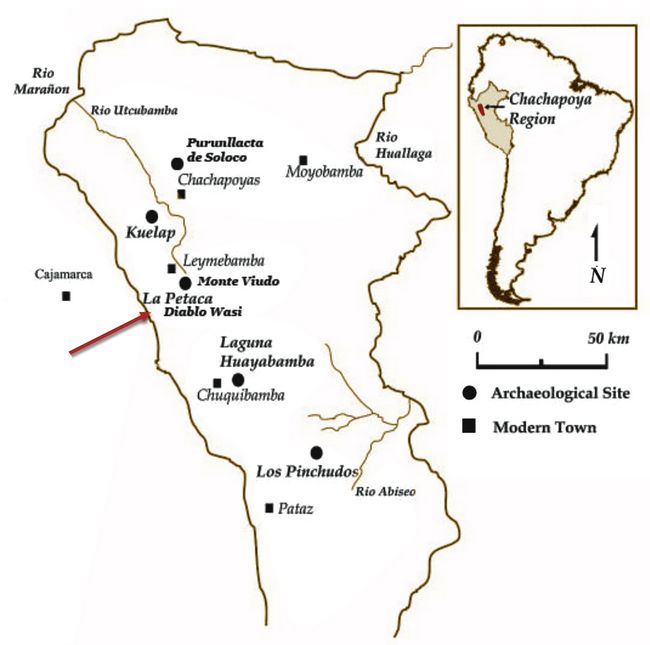 to how social complexity was
experienced in health and diet of these people. However, in some cases,
the commingled and disturbed nature of the remains prevents individual
analysis of complete bodies (the Osteobiography approach) (Saul 1978).
We can estimate the number of individuals in each tomb and the number
of adults and juveniles of each sex, but further detailed evaluation of
pathology is limited. However, innovative research in stable isotopic
analysis of recovered tissues will allow us to reconstruct important
aspects of diet and mobility patterns.
to how social complexity was
experienced in health and diet of these people. However, in some cases,
the commingled and disturbed nature of the remains prevents individual
analysis of complete bodies (the Osteobiography approach) (Saul 1978).
We can estimate the number of individuals in each tomb and the number
of adults and juveniles of each sex, but further detailed evaluation of
pathology is limited. However, innovative research in stable isotopic
analysis of recovered tissues will allow us to reconstruct important
aspects of diet and mobility patterns. Fig.1: Map of South America including Peru, indicating the Chachapoyas region and major archaeological sites in the area.
Previous Work at the Site:
Archaeological remains investigated were selected from La Petaca and Diablo Wasi as the primary mortuary complexes in the Leymebamba district of Chachapoyas region, Amazonas Department, Peru (fig.1). We first began our archaeological research at the site in 2013, investigating the methods for accessing these seemingly impossible to reach tombs (Toyne et al. 2018 in press). We were interesting in identifying the location of all the structures as well as possible access points and constructive techniques. We focused on only a few structures to sample the mortuary construction variation as well as the few archaeological (human remains) that were left commingled within the tombs after many years of extensive looting.
We identified over 125 structures at La Petaca on the largest open rock escarpment alone, but there are 2 other large rock faces we could not reach. Alongside the constructed tombs were natural caves also filled with evidence of mortuary remains.
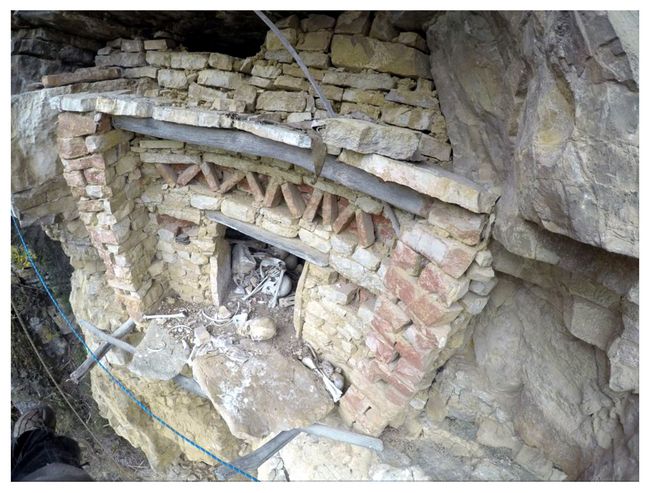 Fig.2: Photograph of elaborately constructed and well-preserved tomb structure at Diablo Wasi, Estructura Funeraria-01 (© Toyne 2016).
Fig.2: Photograph of elaborately constructed and well-preserved tomb structure at Diablo Wasi, Estructura Funeraria-01 (© Toyne 2016).Previous analyses for radiocarbon dating have produced dates of ranging from AD 900 to 1650 for the mortuary structures as well as material remains within the tombs. This suggests that the site was occupied for over 600 years including the construction of new tombs but also the graduate accumulation of bodies within tombs over time. This creates some chronological issues for trying to explore change over time in dietary preferences or social mobility, but we can begin by establishing the local range in variation and comparing to other nearby contemporaneous sites such as Purunllacta de Soloco, Soloco-Chagal district, and Monte Viudo, Leymebamba district, both in the Chachapoyas region (fig.1).
2017 Funded Research Project (RFF-2017-48):
Goals; research objectives and methodology.
This research is based on well-established protocols in dietary and mobility reconstructions using stable isotopes with ancient human tissues (e.g., Ambrose 1993; Katzenberg 2008; Schoeninger 2014), including in the Andean region (e.g., Kellner and Schoeninger 2012; Knudson et al. 2012; White et al. 2009). These methods allow us to explore questions of the nature of social interactions and organization at ancient Chachapoya archaeological sites of the northeastern montane using variation within and between burials and cemeteries and biochemical indicators of diet and mobility.
Are patterns that distinguish mortuary architecture, style, and artefactual remains reflected in dietary variation? Do these dietary indicators show a range in variation across the region? Do isotopic tracers of mobility identity the presence of foreign born individuals? Do isotopic indicators vary by age or sex of the individuals to suggest changes over the life course? Including the study of the human remains, using a bioarchaeological approach, can we identify skeletal indicators of social variation in health, disease, and diet that also complement mortuary variation?
In 2016, we sampled human osteological tissues from different individuals from previous excavations at the inferred elite mortuary sites of La Petaca and Diablo Wasi to answer anthropological questions of subsistence and residential origins: What is the range of dietary variation? Is it different from other nearby residential centers? Are there significant differences between women and men to suggest migration or marriage practices?
This project is a crucial step in a long-term, multidisciplinary, and scientific investigation of funerary practices among the Chachapoya developing techniques in vertical archaeology, mortuary archaeology, biological anthropology, archaeological sciences, engineering, and conservation, with the goals of exploring regional variation and temporal trends of social complexity. The specific focus of this project allowed the post-field work laboratory analysis of skeletal remains and the generation of biochemical data from the mortuary complex of La Petaca and Diablo Wasi.
Research Problem:
Human diets can provide essential clues into past societies. Food often played an important role in social complexity and individual identities (Cuellar 2013; Curet and Pestle 2010; White et al. 2001), and can be used to explore questions of environmental variation and social change over time. Stable isotopic analysis of human tissues have become an important tool for reconstructing ancient dietary patterns, and also for exploring population mobility as isotopic signatures can vary across different geographies.
In the ancient Andes, by the Late Intermediate Period (AD 1000-1470) in many different regions of the north, central, and south coast, as well as the central and southern highlands, we find evidence for state-level social organization and stratified social systems (Stanish, 2001; Smith and Schreiber, 2006). Yet, in the northern highlands and along the eastern slopes of the Andean mountains such evidence among the Chachapoya culture is more elusive and less well understood (Church and Von Hagen 2008; Nystrom et al. 2010; Schjellerup 1997). Here questions of regional identity origins, social complexity, and hierarchy are still being explored. While residential centers offer important clues as to architectural distinctions that may reflect community diversity in social standing (Guengerich 2014; Koschmieder 2012), there are mortuary practices that may differentiate social groups in specific ways reflecting hierarchical access to resources, including food. Social elites may have also established regional connections to distinct communities and long-distance travel or by in-migration of certain members could have cemented positions of social power by controlling trade or access to other valuable resources (Crandall 2012; Guillen 2002; Ruiz Estrada 2009).
This research focuses on reconstructing the diet and mobility of inferred elite burials from La Petaca and Diablo Wasi, Chachapoyas, Peru. We will also compare to new isotope data from burials sampled from nearby and distant residential complexes, as well as recently published data from other elite tombs (Toyne et al. 2017) and the large residential and ritual complex of Kuelap (Toyne et al. in prep.).
Objectives:
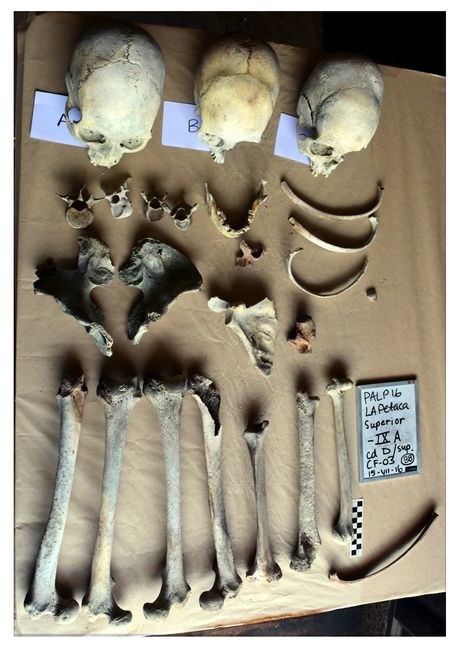 Using
stable isotope ratios of carbon and nitrogen from human tissues (bone
and teeth), we can determine the proportion of C3 (carbon-3) plants
(potatoes, tubers) and C4 (carbon-4) plants (maize) in each
individuals’ diet (Ambrose 1993). We can also assess the relative
proportion of animal protein (llama, guinea pigs, fowl, fish) through
nitrogen isotope values (Katzenberg 2008). If there were social
differences in access to food, we may expect individuals to have less
variation in the diet, or limited access to presumed more valuable meat
sources. In the Andes in particular the majority of the plants are C3
plants with only maize and kiwicha (a high altitude cereal) identified
as C4 domesticated plants. So it is generally expected that identifying
dietary preferences or differences should be well defined.
Using
stable isotope ratios of carbon and nitrogen from human tissues (bone
and teeth), we can determine the proportion of C3 (carbon-3) plants
(potatoes, tubers) and C4 (carbon-4) plants (maize) in each
individuals’ diet (Ambrose 1993). We can also assess the relative
proportion of animal protein (llama, guinea pigs, fowl, fish) through
nitrogen isotope values (Katzenberg 2008). If there were social
differences in access to food, we may expect individuals to have less
variation in the diet, or limited access to presumed more valuable meat
sources. In the Andes in particular the majority of the plants are C3
plants with only maize and kiwicha (a high altitude cereal) identified
as C4 domesticated plants. So it is generally expected that identifying
dietary preferences or differences should be well defined. Fig.3: Photograph of the skeletal material recovered from La Petaca, CF-03, in disturbed cave context (© Toyne 2016).
The oxygen isotopes recovered from our tissues comes from the water we drink (H2O). Water varies across geography based on distance to ocean, elevation, and precipitation. Using baseline water oxygen values, we can identify individuals who consumed local water and those that may be from distant locations (see Toyne et al. 2014; Knudsen 2009).
Since teeth develop during childhood, they record early life diet, and our bones record our later years of life before death. With tooth and bone from the same person, we can identify individuals whose diet and water sources were different during childhood and adulthood, indicating foreigners to the region (White et al. 2006). These methods have generated successful interpretations even among samples that are highly commingled (Gregoricka 2014).
Based on this, we have several specific goals and expectations for laboratory work, which will inform the selection of sites for future archaeological fieldwork.
1) Use human tissues to examine variation in diet (carbon and nitrogen isotope ratios from collagen and apatite) among different burial types (caves, simple, and complex tombs).
2) Use human tissues to examine variation
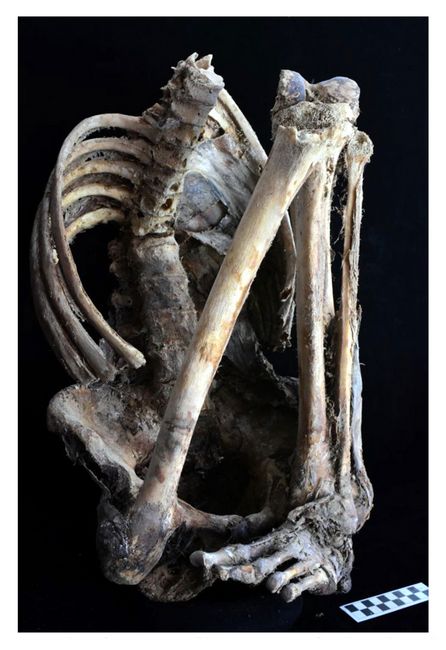 in mobility (oxygen isotope ratios from apatite)
among different burial types (caves, simple, and complex tombs).
in mobility (oxygen isotope ratios from apatite)
among different burial types (caves, simple, and complex tombs). 3) Compare early (teeth) and later forming (bone) tissues to examine patterns in life history changes in diet and mobility.
4) Use these data and comparisons to published data from other mortuary contexts in the region (i.e. Kuelap, Monte Viudo, Los Pinchudos) to explore questions of the intersection of mortuary practices, social identity, and social complexity.
Fig.4: Photograph of a partially mummified individual recovered from Diablo Wasi, demonstrating the excellent skeletal preservation of the osteological tissues (© Toyne 2016).
Project Materials:
All human remains were examined in Peru for standard osteological features indicating age and sex of individuals as well as observing any pathological bone changes. Samples were selected in pairs (teeth and bone) from individuals from different mortuary contexts to represent the range of individuals interred according to different mortuary practices at the sites (fig.2). Samples included juveniles and adults (both males and females). Two partially mummified individuals with unique pathological conditions (1 with advanced tuberculosis and 1 with possible multiple myeloma) were also identified to test for possible variation in diet or mobility due to the impact of those diseases on the health or lifestyle of the individuals (fig.3).
This project includes osteological samples selected from the mortuary complexes of La Petaca (n=67) and Diablo Wasi (n=3) (Figs.4 and 5). Within this sample are 70 human tissues (33 bone, 37 teeth) from 56 individuals (13 have paired tissues). For bones, we preferentially selected ribs, and for teeth we preferentially selected 1st molars for consistency in sampling. We also selected a comparative sample of individuals from nearby archaeological sites of Purunllacta de Soloco and Monte Vuido (n=30 human tissues from 18 individuals), for a total of 100 samples for analysis.
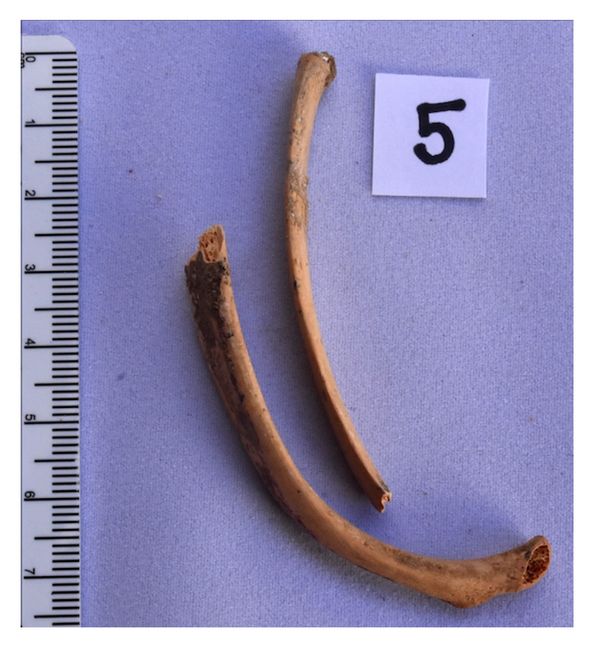 All samples were transported from
Peru to the USA to be prepared and analyzed in the Laboratory for
Bioarchaeological Sciences, at the University of Central Florida,
Orlando, Florida. They were exported under the appropriate permit by
the Ministry of Culture of Peru on March 20th, 2017, under the
Resolución Viceministreral No. 037-2017-VMPCIC-MC for the exportation
of the archaeological samples including human bone and teeth samples.
All samples were transported from
Peru to the USA to be prepared and analyzed in the Laboratory for
Bioarchaeological Sciences, at the University of Central Florida,
Orlando, Florida. They were exported under the appropriate permit by
the Ministry of Culture of Peru on March 20th, 2017, under the
Resolución Viceministreral No. 037-2017-VMPCIC-MC for the exportation
of the archaeological samples including human bone and teeth samples.Fig.5: Photograph of a sample (juvenile rib) selected and prepared for exportation to laboratory for isotopic analysis (© Toyne 2016).
Project Laboratory Methods:
This project employs 3 major methods for preparing and analyzing samples for stable isotope compositions; 1) FTIR is used to test for sample preservation; 2) Analyses of collagen from bone and tooth dentine are used for reconstructions of dietary protein; 3) Analyses of carbonate from hydroxyapatite of bone and tooth enamel are used to determine whole diet and water variation that reflects individual mobility. Each protocol requires a separate sample be prepared and treated.
FTIR:
This method includes the analysis of the infrared spectrums to determine if each sample contains original mineralized proportions of bone and enamel, in order to identify if samples have been diagenetically altered or recrystallized with contaminating minerals (Shemesh 1970; Wright and Schwarz 1996). For this test, we used FTIR (Fourier transform infrared) analysis using an ATR instrumentation adaptation. The graphic spectrum of each sample demonstrate variation in wavelengths consistent with bone mineral properties, specifically the phosphate and carbonate molecules. When samples are diagenetically altered or contaminated, spectrum graphs are distorted and the calculation of the crystallinity index is outside of the accepted range. Those samples were removed from further analysis, but all samples were identified as well preserved.
Collagen Protocols:
Bone and dentine collagen was isolated following the modified method of Longin (1971) (Ambrose 1990). Samples were analyzed on an IRMS (infrared mass spectrometer) at the University of Florida, and resulting δ13C and δ15N ratios were calculated according to known standards.
Carbonate from Hydroxyapatite Protocols:
Apatite sample preparation followed Metcalfe et al. (2009a). Prepared samples were analyzed at the University of Florida and the resulting δ13C and δ18O ratios were calculated according to known standards.
Findings and Research Summary:
The samples produced excellent results and were all well preserved. The CI and C/P analysis on the FTIR indicate that all were within the acceptable range for well-preserved samples, and the collagen yield demonstrate that collagen was also extracted in acceptable quantities.
For the PALP samples (La Petaca) the carbon and nitrogen isotope values will be published forthcoming. The bone collagen δ13C averaged approximately –18‰ and the tooth/dentine collagen δ13C averaged –17‰, which are not significantly different suggesting individuals consumed a consistent diet over the course of their lifetimes. The range of variation in bone δ13C was 9‰ and for teeth it was 7‰, both of which are broad enough to suggest that within this sample, individuals had some variation in dietary preferences both as children and as adults. On average, the approximate –17‰ dietary composition is consistent with a diet that focuses primarily on C3 plants including tubers, vegetables, and fruits and only small contribution of C4 plants such as maize. At an elevation of 3300 meters above sea level, the people living in the region around the mortuary complex were in a region well suited to tuber cultivation over maize, which grows better at lower elevations.
For nitrogen in the diet, which can indicate the degree of carnivory or animal protein, the PALP samples’ bone collagen δ15N averaged +8‰, and the tooth/dentine collagen δ15N averaged +8‰; again not a significant difference. These average nitrogen values are consistent with a population that regularly consumed animal resources. The range is different however, bone ranges 7‰ and tooth ranges 4‰. However, there is a single individual who is driving this difference. With this child removed the bone range reduced to 3‰ similar to the tooth range. This outlier with elevated nitrogen perhaps may have been an individual with a serious, long term illness that affected the nitrogen metabolised by their bodies (Katzenberg and Lovell 1999; Olsen et al. 2014) or may have consumed a very distinct diet than the rest of the group.
We also note that within the sample there are no significant differences between adult males or adult females or between adults and juveniles sampled. This suggests that generally all individuals within this burial complex were consuming similar diets throughout their lives. There is only one dietary outlier within the sample, a bone sample from a child from the Sur EF-01, PALP-51 who has both enriched carbon and enriched nitrogen values. While nitrogen might be interpreted as related to metabolic issues, the elevation of both is likely more consistent with a different diet, including more C4 plants or possibly even more marine resources. Could this child have migrated recently from the coast of Peru up to the highlands of Chachapoyas? Or did this child simply have a unique diet within the community? Since we do not have an exact radiocarbon date for the bone it might also be possible that the child is chronologically distinct from other individuals sampled. Interestingly, the oxygen-isotope values are not distinct from the predicted local water values. Both dietary and mobility isotope tracers are expected to gradually equilibrate to local values over some time but the exact range of turnover is currently not well understood in the scientific literature.
Interestingly, we specifically tested two individuals with evidence for long term, chronic illnesses. In both cases, these individuals produced δ13C and δ15N isotope values that are well within the range of the sample averages, specifically their nitrogen values were slightly below the average rather than elevated as expected for individuals with chronic illnesses (as cited above). We are pursuing ancient DNA analysis of these individuals and others to explore the possible genetic relationships among them as well as possible evidence for bacterial or fungal DNA.
For the analysis of oxygen isotopes and mobility, the results from the analysis of the carbonate samples demonstrate a δ18Osc bone average approximately 26‰ (vsmow), with a range of 3‰. The tooth enamel samples average 24‰ (vsmow), with a range of 3‰. There is a statistical difference between these values to suggest that overall individuals lived in different locations earlier in life compared to later in life. The range of ~3 ‰ suggests that there may be some individuals of non-local origin as it is generally accepted that 2‰ is the expected range for local variation. When we look at the difference between males and females there is more range in isotopic variation in the female tooth values that could suggest that females were more likely to have distant origins during childhood than males, perhaps indicating that females left their natal communities for social contracts or alliances (marriage).
Conclusion:
The mortuary complex of La Petaca and Diablo Wasi, located in the Chachapoyas region of northeastern montane of Peru, holds incredible archaeological potential. In spite of significant looting and natural erosion of the structures the human remains recovered can be used in innovative ways to explore aspects of ancient health, diet, and social complexity. Through the analysis stable isotopes in bone and teeth tissues, these samples demonstrate that the diet was based on local resources but not strongly influenced by maize as in other areas of Chachapoyas or the Andes during later time periods. There are no specific differences between males or females or juveniles to suggest preferential access to resources, including animal protein (meat). It appears that there was some social mobility where among paired tissues for the same individual we can see a notable shift for at least 1 female and 1 male individual (a small sample of 13 individuals). Among the other oxygen isotope ratios, there is more variation about the average to suggest that these individuals may have been residing in different locations during their lifetimes but were interred together along these precipitous cliffs in elaborate chamber tombs. This cliffside cemetery created a new community of the dead.
Current Publications:
Toyne, J. Marla, Armando Anzellini, Lori Epstein, Ismael Mejias Pitti, Jordi Puig Castell, and Salvador Guinot Castello (In Press).
Going Vertical: Using Vertical Progression Techniques to Explore a Cliff Necropolis in Pre-Columbian Chachapoyas, Peru. Advances in Archaeological Practice. Accepted and in press.
Toyne, J. Marla, and Armando Anzellini 2018
Variación y Cronologia De Los Mausoleos y Tumbas De La Petaca. Buletin de Arqueologia de PUCP 27:forthcoming.
Toyne, J. Marla, Armando Anzellini, and Samantha Michell (In Prep.)
Isotopic variation within and among the cliff tombs of La Petaca and Diablo Wasi. Manuscript in preparation for Journal of Archaeological Science: Reports.
Presentations:
2018 Toyne, JM, Schow, C, Esplin, N. Beyond tuberculosis, other pathological spinal conditions in ancient Chachapoya mummified remains. Podium presentation at the Extraordinary World Congress on Mummy Studies, Tenerife, Canary Islands, Spain.
2018 Toyne, JM, Where condors reign. Bioarchaeological investigations in Chachapoyas, Peru. L.I.F.E. at UCF guest speaker, University of Central Florida.
2018 Toyne, JM, Where condors reign: Vertical archaeology and conservation in the mountains of Peru. University of Central Florida, College of Sciences, Distinguished Speaker Series.
2017 Toyne JM. Where condors reign: Methodological challenges in the bioarchaeology of Chachapoya cliff tombs Peru. Podium presentation at the 82nd Annual Meeting of the Society for American Archaeology, Vancouver, Canada. Sponsored session by National Geographic and ESRI.
2017 Toyne JM, Narvaez A. Variación isotópica y mortuoria en la región de Chachapoyas, Perú. Poster presented at the II Taller de Arqueología e Isotopos Estables, Mendoza, Argentina. (In Spanish)
2017 Toyne, JM, El menú en las montañas: explorando la dieta precolombina de los antiguos Chachapoya utilizando un análisis de isótopos estables en Kuelap, Perú. Presented in a Magisterial Conference at the Universidad Nacional Toribio Rodriguez de Mendoza, Chachapoyas, Peru. (In Spanish).
2016 Toyne JM. Accessing an inaccessible history: Collaboration between vertical progression specialists and archaeologists in Peru. Podium presentation at the 4th Annual International Petzl RopeTrip Symposium, Salt Lake City, UT.
2016 Toyne, JM, Visión desde las tumbas: Nuevos conocimientos de patrones funerarias de La Petaca. Presented at the Dirección Desconcentrada de Cultura – Chachapoyas, Amazonas (In Spanish).
2016 Toyne, JM, Nuevos conocimientos de patrones mortuorios de los antiguos Chachapoya en sitios arqueólogos por La Joya, Leymebamba. Presented to the Leymebamba community, Amazonas (In Spanish).
Bibliography:
Ambrose SH. 1990. Preparation and characterization of bone and tooth collagen for isotopic analysis. Journal of Archaeological Science 17:431-451.
Ambrose SH. 1993. Isotopic analysis of paleodiets: Methodological and interpretive considerations. In: Sandford MK, editor. Investigations of ancient human tissue: Chemical analyses in anthropology. Langhore, Pennsylvania: Gordon Breach. p 59-130.
Church WB, von Hagen A. 2008. Chachapoyas: Cultural development at an Andean cloud forest crossroads. In: Silverman H, and Isbell WH, editors. Handbook of South American Archaeology. New York: Springer. p 903-926.
Crandall J. 2012. Chachapoya eschatology: Spaces of death in the northern Andes. Baessler-Archiv 60:1-17.
Cuéllar AM. 2013. The archaeology of food and social inequality in the andes. J Archaeol Res 21(2):123-174.
Curet LA, Pestle WJ. 2010. Identifying high-status foods in the archeological record. Journal of Anthropological Archaeology 29(4):413-431.
Gregoricka LA. 2014. Assessing life history from commingled assemblages: The biogeochemistry of inter-tooth variability in Bronze Age Arabia. Journal of Archaeological Science 47(0):10-21.
Guengerich A. 2014. The architect’s signature: The social production of a residential landscape at Monte Viudo, Chachapoyas, Peru. Journal of Anthropological Archaeology 34:1-16.
Guillén SE. 2002. Las momias de Laguna de los Condores. In: Gonzalez E, and Leon R, editors. Chachapoyas, el reino perdido. Lima: Integra AFP. p 345-387.
Katzenberg MA. 2008. Stable isotope analysis: A tool for studying past diet, demography, and life history. In: Katzenberg MA, and Saunders SR, editors. Biological anthropology of the human skeleton. New York: Wiley-Liss. p 413-441.
Katzenberg MA, and Lovell NC. 1999. Stable isotope variation in pathological bone. International Journal of Osteoarchaeology 9(5):316-324.
Kellner CM, Schoeninger MJ. 2012. Dietary correlates to the development of Nasca social complexity (A.D. 1-750). Latin American Antiquity 23(4):490-508.
Knudson KJ. 2009. Oxygen isotope analysis in a land of environmental extremes: The complexities of isotopic work in the Andes. International Journal of Osteoarchaeology 19:171-191.
Knudson KJ, Pestle WJ, Torres-Rouff C, Pimentel G. 2012. Assessing the life history of an Andean traveler through biogeochemistry: Stable and radiogenic isotope analyses of archaeological human remains from northern Chile. International Journal of Osteoarchaeology 22(4):435- 451.
Koschmieder K. 2012. Jucusbamba. Investigaciones arqueológicas y motivos Chachapoya en el norte de la provincia de Luya, departamento de Amazonas, Perú. Lima: Tarea Asociación Gráfica Educativa.
Longin R. 1971. New method of collagen extraction for radiocarbon dating. Nature 230:241-242.
Metcalfe JZ, Longstaffe FJ, and White CD. 2009. Method-dependent variations in stable isotope results for carbonate in bone bioapatite. Journal of Archaeological Science 36:110-121.
Nystrom KC, Buikstra JE, Muscutt K. 2010. Chachapoya mortuary behavior: A consideration of method and meaning. Chungara, Revista de Antropologia Chilena 42(2):477-495.
Olsen, K.C., White, C.D., Longstaffe, F.J., Heyking, K., McGlynn, G., Grupe, G., & Rühli, F.J. (2014). Intraskeletal isotopic compositions (d13C, d15N) of bone collagen: Nonpathological and pathological variation. American Journal of Physical Anthropology, 153(4), 598-604.
Ruiz Estrada A. 2008. Las cavernas y el poblamiento prehispanico de la provincia de Chachapoyas. Arqueologia: Investigaciones Sociales 7(20):35-62.
Schoeninger MJ. 2014. Stable isotope analyses and the evolution of human diets. Annual Review of Anthropology 43:413-430. 14
Schjellerup I. 1997. Incas and Spaniards in the conquest of Chachapoyas. Archaeological and ethnohistorical research in the northeastern Andes of Peru. Goteberg: Goteborg University.
Shemesh A. 1990. Crystallinity and diagensis of sedimentary apatites. Geochimica et Cosmochimica Acta 54:2433-2438.
Smith ME, Schreiber KJ. 2006. New world states and empires: Politics, religion and urbanism. J Archaeol Res 14(1):1-52.
Stanish C. 2001. The origin of state societies in South America. Annual Review of Anthropology 30:41-64.
Toyne JM, Narváez Vargas A. 2014. The fall of Kuelap: Bioarchaeological analysis of death and destruction on the eastern slopes of the Andes. In: Scherer AK, Verano JW, and Pillsbury J, editors. Conflict, conquest, and the performance of war in pre-columbian America. Washington, D.C.: Dumbarton Oaks Research Institute. p 345-368.
Toyne JM, Narváez Vargas A. In prep. Preliminary evidence of Chachapoya diet and mobility at Kuelap from carbon, nitrogen, and oxygen stable isotopes. Manuscript in preparation for the Journal of Archaeological Science.
Toyne JM, White CD, Verano JW, Uceda Castillo S, Millaire JF, Longstaffe FJ. 2014. Residential histories of elites and sacrificial victims at Huacas de Moche, Peru, as reconstructed from oxygen isotopes. Journal of Archaeological Science 42:15-28.
Toyne JM, Church WB, Luis Coronado Tello J, Morales Gamarra R. 2017. Exploring imperial expansion using an isotopic analysis of paleodietary and paleomobility indicators in Chachapoyas, Peru. American Journal of Physical Anthropology 162(1):51-72.
White CD, Pendergast DM, Longstaffe FJ, Law KR. 2001. Social complexity and food systems at Altun Ha, Belize: The isotopic evidence. Latin American Antiquity 12:371-393.
White CD, Nelson AJ, Longstaffe F, Grupe G, Jung A. 2009. Landscape bioarchaeology at Pacatnamu, Peru: Inferring mobility form d13C and d15N values of hair. Journal of Archaeological Science 36:1527-1537.
Wright L, and Schwarcz HP. 1996. Infrared and isotopic evidence for diagenesis of bone apatite at Dos Pilas, Guatemala: Paleodietary implications. Journal of Archaeological Science 23:933- 944.
Recent Foundation grants: general Archaeology Grants Program w/map
Copyright © 2018 Rust Family Foundation